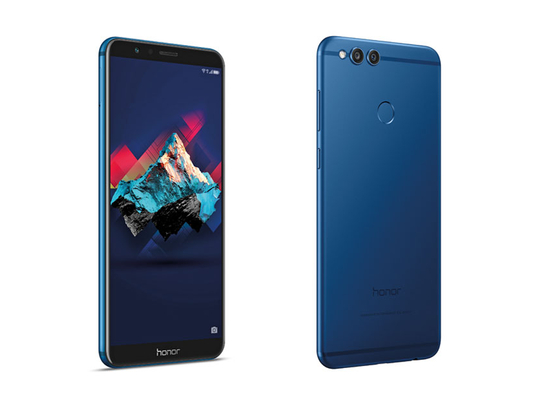
Dubai: Huawei’s millennial-focused brand Honor is finally offering mid-level specification in a great design on 7x with a bezel-less display.
Even though the Honor 7x is not going to challenge the true flagships of today, it can save you a lot of money.
Even the expensive Honor 9 did not have a bezel-less display. With 7x, Honor has made a big jump by bringing 18:9 bezel-less display to the mid-range market for the first time.
The 5.93-inch FullView IPS LCD Display with a resolution of 2160 x 1080 pixels, equalling 408 pixels-per-inch, is coupled with 4GB of RAM and 64GB of storage capacity. Viewing angles are wide, it’s nice and bright and colours are vibrant.
It houses dual SIM-card trays and one of the trays can be used to upgrade the storage capacity up to 256GB.
It is powered by 2.36GHz octa-core home-grown HiSilicon Kirin 659 processor with Mali-T830 MP2 graphics processor.
The phone features a full metal unibody design, measuring 7.6mm in thickness and weighing 165 grams, and feels premium in hand. The rear of the phone houses the fingerprint sensor and can be easily reached. The sensor is so fast and can unlock the device in less than two seconds.
It houses the 3.5mm jack at the base of the device but it is a shame that Honor did not have a Type-C port on this and instead houses microUSB 2.0 port.
Another disadvantage is that it runs on older Android 7.0 version with older user interface EMUI 5.1 out of the box. The latest Huawei Mate 10 Pro comes with the latest Android 8.0 version with EMUI 8.0.
Honor is working with game developers, including Gameloft, to optimise games for the 18:9 screen so that you see more of a scene. Honor has partnered with Gameloft to optimise Modern Combat Versus for the 7X. More games will be able to take advantage of the wide screen in future.
There’s a dual-camera set-up on the rear, with a 16MP sensor doing most of the heavy lifting and then a 2MP sensor to the side of it, which is dedicated to depth-sensing. It means you get the same portrait and wide-aperture modes that you will find on the Huawei Mate 10 Pro.
With Phase Detection Auto Focus (PDAF) and the latest algorithm, the auto focusing is fast on 7X. The wide aperture (F/0.95 — F/16) gives images the DSLR-Level depth of field effect.
The dual lens produce very good snaps with decent lighting but in lowlight conditions it struggles and the colours look washed out and grainy. The images show accurate colours, high detail level and good dynamic range in well-light conditions.
Shots become grainy in dimmer light, but enabling HDR or Night mode does help reduce some of the muddiness.
There is also a Pro mode for those who want to tweak things further. If you’re a photography fan, you’ll likely find the Pro mode useful and enjoyable.
I would recommend turning on the auto HDR option, which is pretty smart. When HDR is needed, the camera does a good job in boosting the shadows without blowing the highlights. HDR isn’t automatic, so you have to select this from the list of modes if you think it’s needed
As there is no optical image stabilisation, you may struggle a little when shooting videos. It can record 4K videos at 30 frames per second and 1080p at 30 frames per second with no 60fps option. Video defaults to 720p, so make sure you choose 1080p to get the best possible quality.
The 8MP selfie camera takes decent snaps in well-light conditions but struggles in low light. You can enable depth effect for blurry backgrounds and gesture support for talking selfies.
In selfie mode, there’s the beauty mode where you can also apply fun masks and effects.
There are lots of other modes, including light painting, time lapse and slow-motion to play with. The video recording is at 720p.
You can take photos by waving your palm instead of having to press a button. By simply raising your palm in front of the camera, the phone recognises your palm and starts a timer. In two seconds, the phone automatically takes a photo of you.
Regarding connectivity, it has Wi-Fi 802.11 b/g/n, WiFi Direct, Bluetooth 4.1 and hotspot but no NFC.
The 3,340mAh battery will last for a day for heavy users, around 20 hours between charges. With power-saving features, it can run more than a day. You can enable Power Saving Mode or Ultra Power Saving Mode to save more power. You can also optimise Apps’ power usage to achieve longer battery life.
In my video rundown test, it lasted around 10 hours of video playback, around 12 hours of web browsing and 21 hours of talk time, which is pretty decent. It is priced at Dh999.
Pros
Premium metal finish
18:9 screen ratio
Value for money
Decent battery life
3.5mm headphone jack
Gesture controls
Cons
No USB Type-C port
No NFC and Bluetooth 4.2
No optical image stabilisation
Older Android version
No 1080p at 60 frames per second
No fast charging technology











